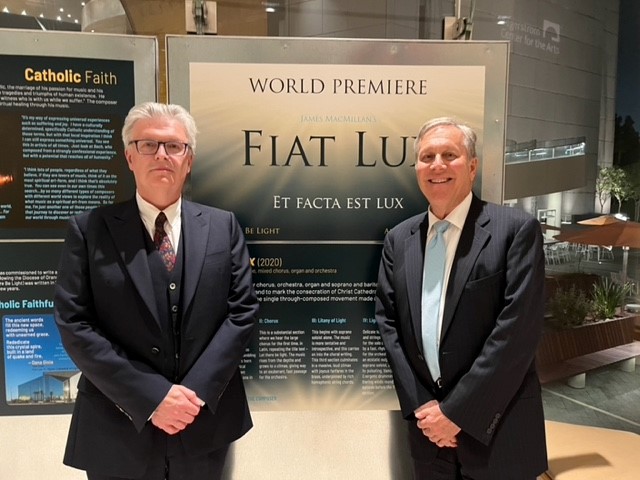On June 20, in the glass-walled light-filled Christ Cathedral, I witnessed the birth of a modern Catholic masterpiece: Fiat Lux (“Let there be light), a collaboration between two great Catholic artists, composer Sir James MacMillan, and poet Dana Gioia, is an oratorio for soprano, baritone, mixed chorus, organ, and orchestra.
“Nearly two hundred musicians took part in the premiere, including 120 members of the Pacific Chorale,” Dana Gioia pointed out to me. “Everyone knew that they were involved in the creation of a major work.”
As Gioia noted, the performance at Christ Cathedral was the culmination of a process that started in rehearsals and continued through three previous performances at Segerstrom Concert Hall in Costa Mesa. “Fiat Lux is a complex work. It required the full skill of every singer and musician. Each evening from the dress rehearsal to the final night in Segerstrom Hall, the performance gathered greater momentum, becoming more assured, luminous, and immediate.
“On the final night, Fiat Lux unfolded from its first to last monumental note with shimmering simplicity and authority. The performers were radiant. So was the audience.”

This new work bringing together Sir James MacMillan and Dana Gioia for the first time was made possible by the generosity of two remarkable patrons of the arts: Howard and Roberta Ahmanson. (The performance at the cathedral was also supported by the National Endowment for the Arts.)
MacMillan and Gioia are probably both familiar to readers of Catholic Arts Today; they have collaborated with the Benedict XVI Institute of Sacred Music and Divine Worship in several significant ways. Sir James MacMillan recently mentored 8 young composers as part of the first-ever Composers Institute the Benedict XVI Institute co-sponsored with the Catholic Sacred Music Project. As for Dana Gioia? “Dana actually chose the name for CatholicArtsToday.com, our journal dedicated to the life and the arts of living Catholic artists across the disciplines,” notes executive director Maggie Gallagher, “He also directed us to James Matthew Wilson (our poet-in-residence) telling me James is no less than ‘the future of Catholic letters in America.’”
The concert on June 20 began with Alexandre Guilmant’s “Premiere Symphonie pour orgue et orchestra,” which showcased the Cathedral’s wonderful refurbished Hazel Wright Organ, the fifth-largest pipe organ in the world—with more than 17,000 pipes. Prodigiously talented Paul Jacobs, who is said to be the only Grammy award-winning organist ever (in 2011 for Messiaen’s Livre du Saint-Sacrement) ably demonstrated the capacities of “the Hazel” (as it is affectionately known). Jacobs told the audience that a priest friend of his when he was growing up, Father John, had attended the dedication of this very organ when it was first installed in 1982, and he had told Jacobs he had “never heard anything like it.”
I have to say the same. I’ve never heard such a grand organ sound so mellow, with no squeaks or squeals or harshness, just beautiful rich sound.
Setting Radiant Expectations for the Cathedral Performance
The early reviews of Fiat Lux at the Segerstrom concert hall set radiant expectations for the Cathedral performance.

The Benedict XVI Institute’s composer-in-residence Frank La Rocca wrote on Facebook:
“I can only say ‘and there was light.’ Glorious, moving, spectacular light. Bravo to MacMillan and Gioia on this masterpiece!”
Mark Swed, a veteran Los Angeles Times classical music critic, ecstatically approved in his review, The refurbished Christ Cathedral, and its humongous organ, find unexpected magnificence:
“’Fiat Lux’ is in five sections and begins with ‘In the beginning.’ The Earth is without form and void, but there is air. The strings make weird flickering noises while brass players become wind-makers blowing ethereal breaths into their instruments. A solo baritone chants the biblical text in Latin; a soprano responds in English. Deep brass take us from the depths of the waters, Wagner-like, to the surface.
“The chorus, in the old musical forms of canon and fugue, demands light. Let there be light (fiat lux) is first a glimmer, and then, there is light. As far as I could tell, no one touched the light switches in Segerstrom, but the explosion of mass voices and orchestra and organ so overwhelmed the senses, I wouldn’t swear to that.”
Equally adulatory was the preview article at Classical Voice titled Pacific Chorale and Symphony Spark Life Into James MacMillan’s Fiat Lux,
San Francisco Classical Voice critic Victoria Looseleaf writes. “MacMillan, an outspokenly Catholic composer, has been exploring sacred themes for decades. His religion has influenced ‘a lot of what I’ve done, but not every piece I write is sacred. . . . Dana’s poem celebrates this place that is California, and there are references throughout. It hints at the consecration of a sacred space, but beyond that it’s the sacred space of this land, California.’”

I attended the June 20th performance with high expectations of sharing in some of that luminosity. I was not disappointed. I might even still be glowing.
Before the performance, Carl St. Clair, conductor of the Pacific Symphony Orchestra, interviewed Gioia and MacMillan together. Dana Gioia spoke at some length about his creative process:
“When I realized I had the honor of collaborating with James MacMillan, one of the greatest composers in the world, to celebrate the rededication of this iconic modernist church as a Catholic cathedral I knew the work that we created had to be special, had to reflect the place. I began thinking of what it’s like going into European cathedrals. They’re vast. They’re solemn. And they’re shadowy. But here you’re suffused by light. This is a modern building in which we are bringing the ancient rites of the Church. I thought that dichotomy had to be reflected,” he said. “Is there a greater act of faith than building a glass cathedral in California?”
Dana, who is a native Californian, and former poet laureate of California, went on:
“It just struck me. You’ll see it in the opening lines of the final hymn.
“‘Upon this rock,
Our cross and spire
built in a land
of quake and fire.
“’Fragile as glass,
bright as the air,
the angled walls
folded in prayer.”
“I wanted to literally celebrate this space in which we now celebrate the sacraments. So the pitch I made to James was, ‘Don’t you think we could build the whole work around the idea of light?’ And that prompted the structure of the piece.
The next chance to hear Fiat Lux is August 13, when the classical music station KUSC will broadcast it (including over the internet).
Dana Gioia ended his remarks with this humorous summary of Fiat Lux: “It begins when God creates the world and ends in Garden Grove.”
(You can find the full text of the oratorio on the last page of the program for the performances at the Segerstrom Concert Hall.)


After earning a B.A. in English and Studio Arts, and an M.A. English, emphasis writing, followed by a career in technical writing and course development in the computer industry while doing other writing on the side, Roseanne T. Sullivan now writes full-time, publishing poetry, reviews, and essays about sacred music, liturgy, art, literature, architecture, and whatever else strikes her Catholic fancy.




